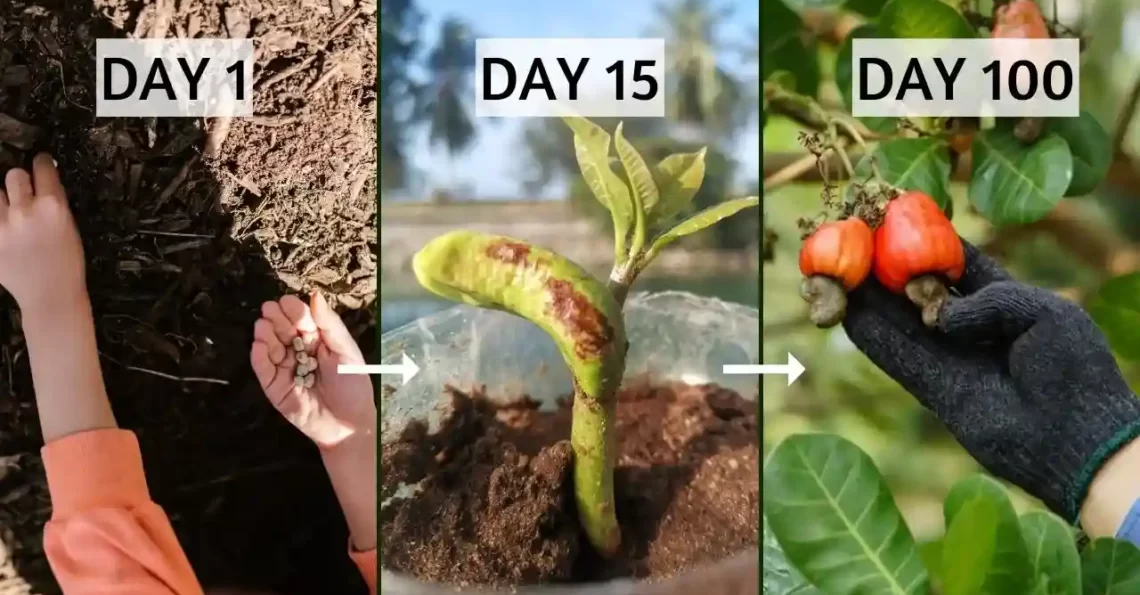How to Grow Cashew Kaju Tree
Srishti Singh2024-06-26T00:46:47+05:30Just like the Cashew Nuts “Kaju”, the majority of cashew tree parts have a specific purpose and have significant nutritional value for human health. Delicious cashew nuts and high food value quickly made the trees popular and led to their transformation into a highly commercial food.
But do you know how to grow a Cashew Tree? Only some of you might have an idea about how to grow and take care of the tree but some of you must be still wondering whether you can grow the cashew tree or not. So, in this blog, we are going to study about what are the requirements of the Cashew Tree and How to grow them?
Table of Contents
ToggleAbout Cashew Trees
The cashew tree (Anacardium occidentale) is an evergreen shrub or tree that is generally found in the tropical region and provides us with Cashew nuts and Cashew Apples. The height of cashew nut trees ranges from 3 to 9 meters. Raw cashew nuts have hard outer shells, concave structures, and stalks that protrude in a pear-like shape.
The shells do not self-open and require total care and knowledge to extract a single cashew from the Cashew apple. The trees grow best on sandy soil, which is typically non-fertile and does not retain much water, but trees will still thrive without additional fertilizer.
Growing Cashew Trees

If you reside in a tropical country like India, regardless of whether the climate is rainy or dry, you can start cultivating cashews with ease. The ideal temperature to grow the Cashew tree is neither too cold (below 10 C) nor too hot (over 40 C). In any place free from frost, you can begin planting cashews and cultivating them.
Cashew trees are relatively simple to grow in an atmosphere with a temperature range of 10 to 40 C, with a little water, can survive on coastal soils, and are quite a drought tolerant. Cashew plants require 5 to 7 hours of sunshine daily on average.
It’s important to consider factors including timing, technique, water level, and humidity when growing cashew nuts. Now let us look at some requirements the Cashew trees need for their growth.
How to Grow Cashew Tree
After considering all the requirements of the cashew tree, start planting the cashew tree as per your requirement and land availability. These steps include:
Points to Remember
- The cashew growing region’s temperature ranges from 10 to 40 C.
- To give the Cashew tree’s root successfully create a pit hole of about 10 cm deep.
- Toto provides each cashew tree ample room to flourish, the trees are placed 9.1 m apart.
- The finest outcomes come from using the freshest seed possible.
- The cashew trees grow well in red soil or sandy soil.
- In regions with rich soil layers and sufficient drainage, cashew trees flourish and provide significant yields.
Method For Growing Cashew Trees

Step 1:
Buy some fresh seeds or a small plant from the shop and keep them in a dry place.
Step 2:
Dig a small hole considering the distance between two Cashew trees and the depth of the dig according to the requirement where sufficient sunlight is available.
Step 3:
Place the tree or the seeds in the center of the hole and cover it with the sandy soil that was removed while digging the hole.
Step 4:
Ensure again that the seed or the small cashew plant is deep inside the soil by applying small pressure with your palm on each side of the place.
Step 5:
Create a small round around the seed or the tree considering 15 cm diameter and elevate the soil inside the circle slightly.
Step 6:
If the soil is too dry, water it regularly two times a day to keep the soil moist and wet.
Step 7:
After one week grab some organic manure and provide it to the plant according to the plant’s requirement. If the plant has already started flouring, give only a few amounts of manure and if the plant has not shown any activity in a week or two, provide the manure in sufficient amounts.
Step 8:
After 3 months, provide some more manure and prune your tree from the axis if it has already grown into a bush.
The Season For Planting Cashews Trees
Cashew tree planting is best done at the start of the rainy season, right after the first rain falls on the ground. It will become permeable and simple to maintain. Additionally, throughout the rainy season, the cashew trees will experience good & speedy growth. The best time to plant in India is when the rainy season is consistent, which is often from June to August.
Distance And Density Between Cashew Trees
Pay close attention to the density and space between the cashew trees during planting. Cashew trees should originally be planted thickly to have great yield. Afterward, the central trees should be removed when they have spread out.
- The initial separation should be 48 or 50 meters per square
- Next, remove the trees in the center to create a larger space to let the trees grow and plant them somewhere else.
Method For Digging Holes
Always remember to create a box-shaped hole that must be 60 cm deep under the ground. The top layer of loose dirt and humus on one side of the pit should be removed during the digging and later on used to fill up the hole after planting the cashew tree.
Other Requirements of Cashew Trees: Light, Temperature, Rainfall, and Soil
The cashew tree is a high-yielding, high-quality plant. They need proper care and attention while they are growing. 4 things require special attention: light, temperature, humidity, and soil.
Soil
We can cultivate cashew trees on a variety of soil types. However, deep soil layers and efficient drainage are the only conditions for cashew tree high yields. The cashew tree can grow well in sandy-clay soil where there is groundwater at a depth of 3–6 meters the good drainage provided by sandy soil, cashew trees can thrive there. Additionally, cashew trees can grow and develop very well in red soil.
The soil which is unsuitable for the Cashew tree to grow is heavy clay soil, hilly terrain with floating rock layers, and loose sandy soil. For cashew trees, some types of soil only produce very little or no fruit.
Light
Cashew trees can grow in full sunlight and bear fruit at the top of the branches, so they can be grown alone or in proper densities to get the right amount of light for a good yield. The plant demands more light when it is blossoming.
Cashew plants require 5 to 7 hours of sunshine daily on average.
Rainfall
The ideal annual rainfall for cashew tree growth is 1,000–2,000 mm. The rainy season and the dry season are two distinct climates where cashew trees can be grown. Cashew trees develop and store nutrients throughout the rainy season so that when the summer season arrives, they will bloom and provide good fruit.
Temperature
Cashew thrives in tropical environments and is particularly vulnerable to freezing temperatures. Although cashew may grow in a pretty wide temperature range (7 to 46 degrees Celsius), it only grows and develops well in this range.
Water Requirement for cashew trees
The water requirement of cashew trees differs from season to season and the stage of plant growth. This water requirement is briefly explained which you can consider watering your cashew trees
- Watering small cashew nuts twice a day
When the cashew tree is young, fresh, and has just been planted in a long-term hole. Don’t forget to give the cashew tree two daily watering—in the morning and the afternoon.
- Watering during the dry season
The young cashew tree has taken root, grown tall, and can survive on its own by the end of the rainy season. However, you must continue watering the plants during the first few months of the dry season until the seedlings are six or seven months old. This aids in ensuring that the root system of the cashew tree is functioning properly and soaking up enough water to sustain the tree despite the extreme heat.
- Watering the cashew after it becomes a mature tree
Watering the fully mature tree is difficult as it requires a lot of water. The water is extracted by the underground water which assembles during the rainfall. The cashew tree can survive with just 500mm of rain each year on average. However, if there is plenty of water available during the dry season, even once or twice a week, the cashew tree will get lusher and produce more nuts.









